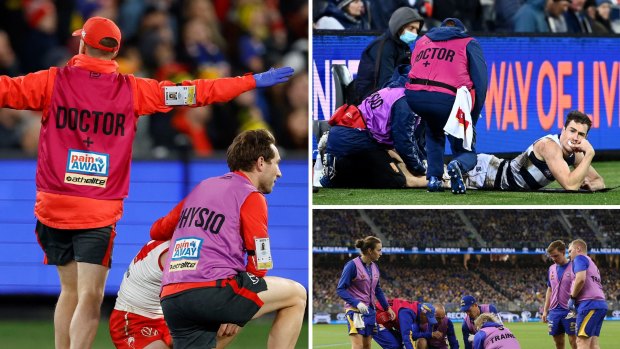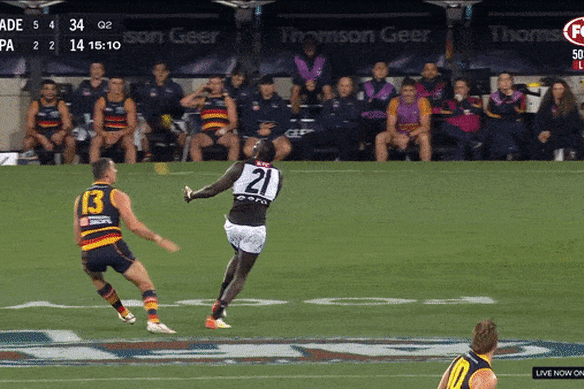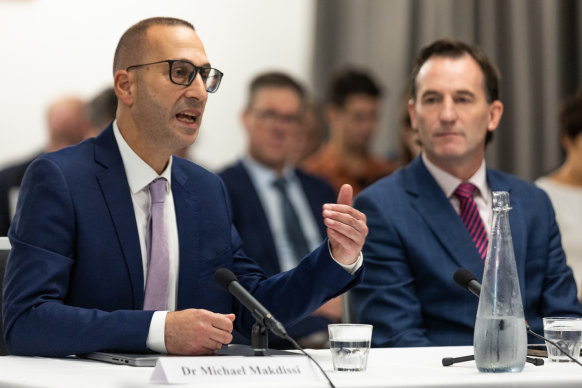Why would you be an AFL club doctor?
Save articles for later
Add articles to your saved list and come back to them any time.
When I was first appointed as a VFL club doctor at Melbourne in the 1980s, it was regarded as a great job for those of us working in sports medicine, especially if you had grown up in Victoria or one of the other footy states. I guess an NRL job would have been similarly attractive to those in the northern states.
Back then, being a club doctor meant attending training on Tuesday and Thursday evenings, and Saturday matches (all in Victoria) with a 2pm start, followed by a relaxed injury clinic on a Sunday morning.
The work of an AFL club doctor has become more complex and demanding over the years.Credit: Getty
The pay was reasonable (no soft cap to limit football department spending in those days), the hours compatible with family life and maintaining your own clinical practice, concussion was thought to be a “reversible condition” with no long-term effects, and there was no suggestion of legal action against doctors.
Things are certainly different now, and it is no surprise that clubs sometimes struggle to find a well-credentialed, experienced doctor, such are the demands placed upon them. Most AFL clubs have two senior team doctors who share the training load and are both on the bench on match day.
One of the doctors is at every training session, which basically means that someone is there each day except for the players’ day off, although there is often a medical issue to deal with on that day as well. Weekends are disrupted for one, two or three days depending on whether interstate travel is involved.
The club doctor is constantly involved in discussions with the coaches, high-performance manager, fitness staff, physiotherapists and other club personnel. The doctor arranges and usually attends players’ specialist appointments and spends numerous hours on the phone discussing imaging results and surgical options with other specialists.
The club doctor is on call 24 hours a day, seven days a week and is expected to deal with issues as they arise with not only players but also coaches, other staff and players’ families. Then on match days they make spur-of-the-moment decision which, if they saw the same player presenting to their clinic, would require a detailed history and examination in addition to relevant imaging. Only then, and probably after discussion with colleagues, would a plan of action be formed. The club doctor has to do all that in minutes, under enormous pressure.
Time spent at the club makes it extremely difficult for the doctor to maintain and grow their own clinical practice, often to their long-term financial detriment. The club doctor’s remuneration, particularly since the soft cap cutbacks, is considerably less than what they would earn spending a similar amount of time in the clinic. It is a labour of love!
The days of coaches pressuring club doctors into allowing players to return to the game are thankfully over; within football clubs the primary concern is for the health of the player. Nonetheless, a doctor who is employed or contracted by the football club is well aware of the consequences of a decision to remove a star player from the game. Now, with a minimum 12 days on the sidelines after a concussion, that diagnosis has even greater consequences.
Never have the actions of the club doctor attracted so much scrutiny, and the clash of heads between Port Adelaide players Aliir Aliir and teammate Lachie Jones is only the latest example. The scrutiny comes from both the AFL itself with an independent doctor viewing the game from a hub alongside the AFL review centre (ARC) charged with alerting the doctors on the bench to an incident they may have missed which could involve a concussion, and from the media which is catering to the public’s insatiable appetite for football news.
Port Adelaide teammates Aliir Aliir and Lachie Jones collide against Adelaide on Saturday night.Credit: Fox Footy
Our understanding of concussion has improved enormously over the past few decades, but there is still considerable uncertainty and disagreement regarding the diagnosis, management and potential long-term effects. Frequently the diagnosis is obvious, such as when a player is knocked unconscious, has a convulsion or is unsteady on their feet. However, sometimes it is not clear at the time, or symptoms can develop later, a so-called “delayed concussion”.
The AFL and other football codes have a protocol that must be followed when a concussion is suspected. It involves taking the player back into the rooms and conducting a full assessment, including a SCAT5 test which assesses cognition, memory, balance and decision-making in addition to the player’s symptoms and examination findings. If the assessment shows any suggestion that a player has been concussed the decision will be made to remove them from the game.
The AFL doctors have been at the forefront of many of the rule changes implemented over the past few years to reduce the incidence and severity of head knocks. The league is fortunate to have Dr Michael Makdissi as its chief medical officer. As well as having had a number of years as a highly respected club doctor, Makdissi has a PhD in concussion research – I was a co-supervisor – and is widely regarded internationally as one of the world experts on this condition.
AFL chief medical officer Michael Makdissi, beside the league’s incoming CEO Andrew Dillon, answering questions earlier this year at a Senate inquiry into concussion.Credit: Jason South
The current environment has meant that in the past few months Makdissi has had to appear before a Senate inquiry and the Coroner’s Court to explain the AFL’s policies both past and present. The threat of legal action hangs over all AFL medical staff with actions by former players, including Ty Zantuck and Liam Picken, specifically citing club doctors as well as the club and the AFL.
So, why would any doctor put themselves under such scrutiny with the threat of legal action for less pay than they would get elsewhere? The AFL, the players and the public should be thankful that there is a handful of skilled, dedicated, caring doctors, whose main concern is the welfare of the players, to undertake these important jobs.
Peter Brukner is Professor of Sports Medicine at La Trobe University. He has worked for AFL clubs Melbourne and Collingwood, the Australian Olympic team, the Australian men’s cricket team, the Socceroos, and English Premier League club Liverpool.
Keep up to date with the best AFL coverage in the country. Sign up for the Real Footy newsletter.
Most Viewed in Sport
From our partners
Source: Read Full Article



